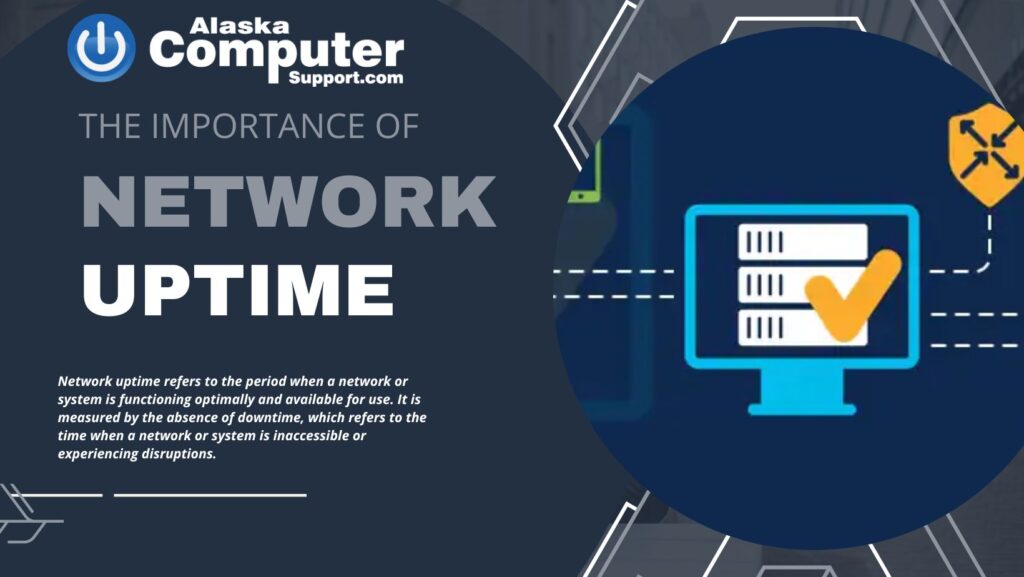The Importance of Network Uptime

In this digital age, where businesses heavily rely on technology, network uptime has become a critical aspect of operations. This blog post explores the significance of network uptime and its impact on businesses and customer satisfaction.
What is Network Uptime?
Before delving into its importance, it’s crucial to understand what network uptime entails. Network uptime refers to the period when a network or system is functioning optimally and available for use. It is measured by the absence of downtime, which refers to the time when a network or system is inaccessible or experiencing disruptions.
The Role of Network Uptime
Network uptime plays a vital role in various aspects of business operations, ensuring continuity, productivity, and customer satisfaction.
Ensuring Business Continuity
Network downtime can bring businesses to a standstill, resulting in significant financial losses and damage to reputation. A reliable network uptime ensures continuous operations, allowing employees to carry out their tasks seamlessly and preventing disruptions in critical business processes.
Maintaining Productivity
Productivity is closely tied to network uptime. When network systems are consistently available, employees can efficiently collaborate, access necessary resources, and complete their work on time. On the other hand, network outages lead to wasted time, decreased efficiency, and missed deadlines.
Enhancing Customer Satisfaction
In today’s customer-centric business landscape, providing a seamless digital experience is paramount. Network uptime directly impacts customer satisfaction by enabling smooth transactions, quick response times, and uninterrupted access to online services. Customers expect reliability, and any downtime can result in frustration, dissatisfaction, and potential loss of business.
Impact of Downtime
Network downtime can have severe consequences for businesses, affecting their financial stability, reputation, and competitive advantage.
Financial Losses
Extended network outages can lead to significant financial losses. Every minute of downtime can result in revenue loss, especially for e-commerce platforms and businesses heavily reliant on online sales. Additionally, downtime may incur additional costs associated with troubleshooting, system repairs, and customer compensation.
Reputation Damage
Businesses that experience frequent or prolonged network downtime risk tarnishing their reputation. Customers expect reliability and prompt service. When a company fails to meet these expectations, it can lead to negative reviews, customer churn, and a damaged brand image that is challenging to recover.
Competitive Disadvantage
In today’s hyper-competitive market, downtime can give competitors an edge. If a business consistently experiences network issues, customers may turn to more reliable alternatives. Maintaining a robust network uptime ensures that businesses can remain competitive, retain customers, and attract new ones.
Factors Affecting Network Uptime
Several factors influence network uptime, and understanding them is crucial for maintaining a reliable network infrastructure.
Network Infrastructure
The design and quality of a network infrastructure play a significant role in uptime. A well-designed network with redundant components, scalable architecture, and sufficient bandwidth can mitigate the risk of downtime. Investing in high-quality networking equipment and proper network configuration is essential for ensuring optimal uptime.
Redundancy and Failover Systems
Redundancy and failover systems are vital components of network infrastructure that contribute to network uptime. By incorporating redundant hardware, such as backup servers, switches, or routers, businesses can mitigate the risk of single points of failure. Failover systems automatically switch to backup components when the primary ones experience issues, ensuring uninterrupted network availability. Implementing redundancy and failover systems adds a layer of resilience and helps minimize the impact of hardware failures or network disruptions.
Proactive Monitoring and Maintenance
Proactive monitoring and maintenance are key practices for ensuring network uptime. By continuously monitoring network performance, IT teams can identify potential issues before they escalate into major problems. This includes monitoring network traffic, bandwidth utilization, and system health. With proactive monitoring, IT professionals can promptly address emerging issues, apply necessary patches or updates, and optimize network performance. Regular maintenance tasks, such as hardware inspections, firmware updates, and system optimizations, help maintain a stable and reliable network infrastructure.
Best Practices for Ensuring Network Uptime
To maximize network uptime, businesses should follow best practices that focus on preventive measures and regular maintenance.
Regular Updates and Patches
Keeping network devices and software up to date is crucial for maintaining a secure and reliable network. Regularly applying updates, security patches, and firmware upgrades helps address vulnerabilities and ensures compatibility with the latest technologies. This practice minimizes the risk of network breaches, performance issues, and compatibility conflicts, thus enhancing network uptime.
Implementing Backup Systems
Implementing backup systems is essential for network resilience and data protection. Regularly backing up critical data and configurations safeguards against data loss in the event of a network failure or disaster. Backup systems, such as off-site storage or cloud-based solutions, offer redundancy and quick data recovery options. By having reliable backup systems in place, businesses can restore operations swiftly and minimize downtime.
Conducting Routine Network Assessments
Routine network assessments are instrumental in identifying potential weaknesses and areas for improvement. Regularly reviewing network infrastructure, conducting security audits, and performing penetration testing help identify vulnerabilities and potential points of failure. By addressing these issues proactively, businesses can strengthen their network’s resilience, reduce the likelihood of downtime, and improve overall network performance.
In conclusion, network uptime is of paramount importance in today’s technology-driven business landscape. It ensures business continuity, maintains productivity, and enhances customer satisfaction. The impact of network downtime can result in financial losses, reputation damage, and competitive disadvantages. To ensure optimal network uptime, businesses should focus on factors such as network infrastructure, redundancy, failover systems, proactive monitoring, regular updates, implementing backup systems, and conducting routine network assessments. By following these best practices, businesses can minimize downtime, provide a reliable digital experience, and stay ahead in a competitive market.
